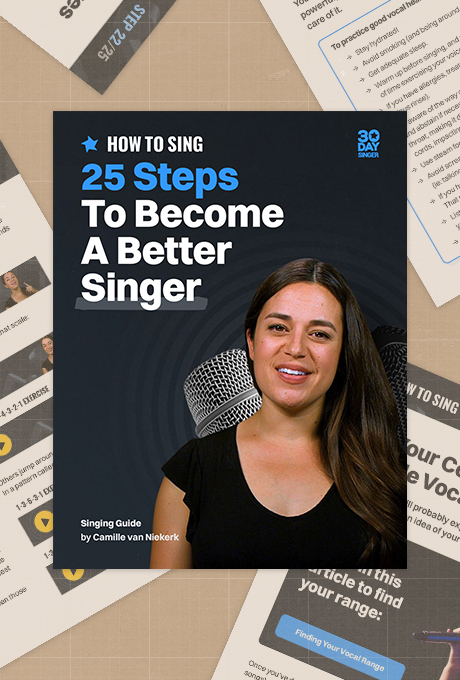A Beginner's Guide To Vowel Modification
April 30, 2021
By Camille van Niekerk
Vowel modification is simply changing a vowel sound to make it easier to sing AND improve the tone quality.
Why do we need to know how to sing with vowel modification?
Each vowel is the result of a slightly different shape in your vocal tract (the pathway from your larynx to your lips).
Different mouth posture, tongue placement and lip closure make up the difference between an EE sound and an OO sound, for example.
It’s getting a little science-y, but in this singing lesson it'll all become clear.
What is Vowel Modification
In simple terms, vowel modification is a singing technique singers use to tweak vowel sounds to make singing easier and more comfortable.
Especially when hitting high notes or sustaining longer phrases.
Your mouth and throat - which together make up your vocal tract - “boost” frequencies within the sound wave created by your vocal folds.
You can hear this clearly when you move from an EE vowel to an OO vowel on the same pitch.
Notice how your tone is very bright, maybe even nasal on the EE vowel, and notice how it gets significantly “darker” or “warmer” on the OO vowel.
Main Uses for Vowel Modification
1) Improve Tone Quality
If your tone is overly bright, for example, you might modify your vowels closer to a warmer UH or OO shape.
Lewis Capaldi and Adele are two singers who use this kind of modification a lot, resulting in a warm, rich tone.
Especially in their low chest voice ranges.
If your tone is overly dark on the other hand, you might modify your vowels closer to a bright EE, EY (as in HEY) or A (as in CAT) shape.
Notice how your tongue and lips are positioned to make these brighter vowel sounds.
Use a similar position when you want that sound.
2) Achieve Desired Registration
In order to do this, we need to understand 3 basic vowel categories, adapted from John Henny’s “Teaching Contemporary Singing:”
Narrow vowels
Mouth position: closed
Examples: OO (as in cool) and EE (as in bee)
Great for: head voice
Use when: you want a lighter tone
Medium vowels
Mouth position: neutral
Examples: UH (as in cup) and ʊ (as in book)
Great for: mixed voice
Use when: you’re in middle/mixed voice or crossing registers
Wide vowels
Mouth position: wide and/or open
Examples: EY (as in hey) and A (as in yeah)
Great for: chest voice
Use when: you want a heavier, chesty tone
Pro tip: These vowel categories really come in handy when you’re singing in your mix or middle vocal range!
If you notice that you’re “flipping” into head voice (and don’t want to), try a slightly wider or more open mouth shape.
If you’re getting too heavy or loud, try a slightly more closed shape.
To summarize and simplify: medium vowels (UH as in CUP and ʊ as in BOOK) are almost always helpful.
Check out 30 Day Singer for the best singing lessons online!
Lyric Work
If you’re having trouble with a specific section or lyric:
1. Remove the lyrics and sing on a syllable like MUM or BʊB (“BOOK” vowel sound)
2. Check your mouth position in the mirror: are you gently dropping your jaw? Is your mouth in a neutral shape?
3. Modify the problematic vowel to a shade that’s easier to sing. For example, if EE sounds tense but UH sounds balanced, a good “shade” of that EE vowel may be something closer to IH (as in GIVE).
4. Rehearse until it’s muscle memory!
Summing up: Vowel modification is an art, not a science.
If no modification is needed (ie: you’re happy with the tone quality and registration), then great!
But most songs will require at least some amount of vowel modification, even if it’s just on a lyric or two.
It will become more natural the more you do it.
Just remember that as singers, we don’t need to pronounce our words exactly as we’d speak them.
We prioritize beautiful tone over perfect diction, but we do our best to remain intelligible!
Listen carefully to your favorite singers - or even better, watch recordings of live performances - and see if you can identify some vowel modification.
FAQ
What is an example of a vowel modification?
An example of vowel modification is changing the "A" sound in "cat" to sound more like "uh" in "cut" when singing higher notes to reduce strain.
What are vowel modifiers?
Vowel modifiers are slight adjustments singers make to the shape of their mouth and position of their tongue to tweak vowel sounds for better vocal comfort and control.
Why is vowel modification important?
Vowel modification is important because it helps singers hit higher notes more easily and sustain phrases without straining their voice, leading to a smoother, more pleasant sound.
What changes the sound of a vowel?
The sound of a vowel changes based on the shape of the mouth, the position of the tongue, and the tension in the vocal cords.
What is vowel variation?
Vowel variation refers to the slight changes in vowel sounds that singers make to accommodate different pitches and vocal demands, ensuring more consistent and comfortable singing.
What are the rules for vowel sounds?
The rules for vowel sounds involve understanding how mouth shape, tongue position, and breath control affect the production of each vowel, helping singers modify these sounds for better vocal performance.
What is the 3 vowel rule?
The 3 vowel rule in singing suggests that for each vowel, there are three positions or modifications that can be used to adjust the sound for different pitches or vocal situations.


